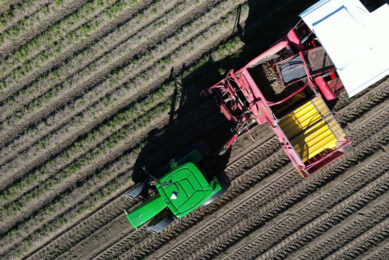Sensor measures presence of soil insects to indicate soil health

Last summer, five participants in the Dutch precision farming research project NPPL worked with a sensor to measure presence of soil insects. Two sensors were trialled on the Dutch Farm of the Future.
Wageningen University & Research expert Eva de Jonge, who leads the research, emphasises that the soil insect measuring sensor is a prototype. The growers who participate in the project find the sensor interesting. However, they would like to compare the data with those from other plots and colleagues.
The sensors come from a collaboration between Syngenta and a Hungarian university. They are capable of measuring springtails and soil mites (acarii and collembola). The presence of these soil insects is an indicator of soil health. These insects are most important in humification, the conversion of soil organic matter, according to research.
Soil insect sensor controlled by an app
The sensor is controlled by an app on the phone (Edapholog, available via Android). De Jonge: ”On the app you can see which insects the sensor has counted. You can see a picture of the last insect. The other photos go to Hungary for analysis.”
After measurement, the insects are automatically collected in a tube of alcohol that also goes to Hungary. There, De Jonge said, they use the data to further improve detection.
Substantial numbers of insects counted

The sensors were tested at Farm of the Future and at NPPL participants Jacob van den Borne, Klaas Schenk, Remco Wesdorp and Cornelis Mosselman. Substantial numbers of insects were regularly counted. ”The sensor provides various scientific indexes with it that allow you to see how your sample is doing. The indexes include the diversity of insects in the sample, the numbers and size of soil mites and springtails measured,” says De Jonge. The insects were observed by the camera in the sensor and classified with software.
De Jonge stresses that this is a prototype. “They are still too sensitive to interference at the moment. However, we did notice during the season that the professors who made the sensor really thought along and kept coming up with updates. We gave a lot of feedback about the app to the university in Hungary and improvements were rapidly made.”
Response from NPPL participants
The researcher herself collected responses from NPPL participants. She noted, “Very interesting to know more about my soil life!”, but also “To compare different plots at the same time, you actually need two”. One grower needs comparisons. ”The sensor counts the insects well but it was difficult to look at and understand the data itself. How does my soil compare to a colleague’s?” Another grower weighed in on the influence of conditions: “When it’s a bit drier, the insects crawl deeper into the soil. Then it is difficult to take a reliable sample”
De Jonge agrees that measuring was difficult in this hot, dry summer. ”For a long period, there was no point taking samples except on irrigated stretches. If all goes well, we can just continue measuring this autumn and winter.”
Watch a video of the insects on the sensor. You can see them falling and then being blown away:
Join 17,000+ subscribers
Subscribe to our newsletter to stay updated about all the need-to-know content in the agricultural sector, two times a week.



